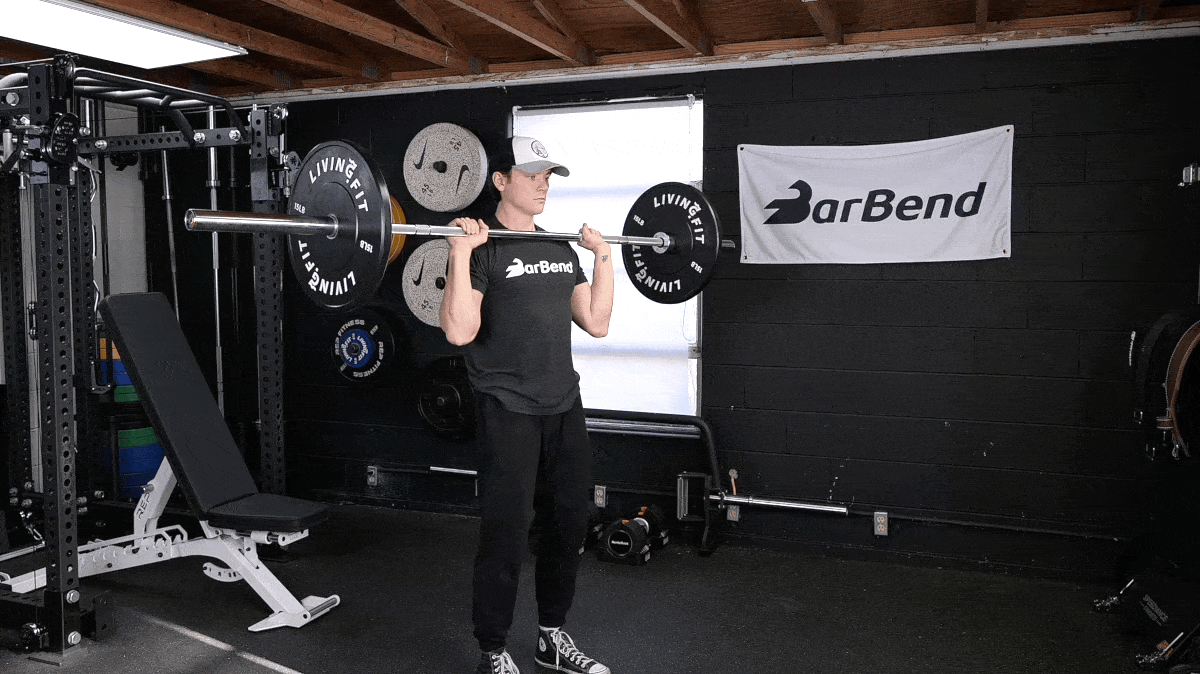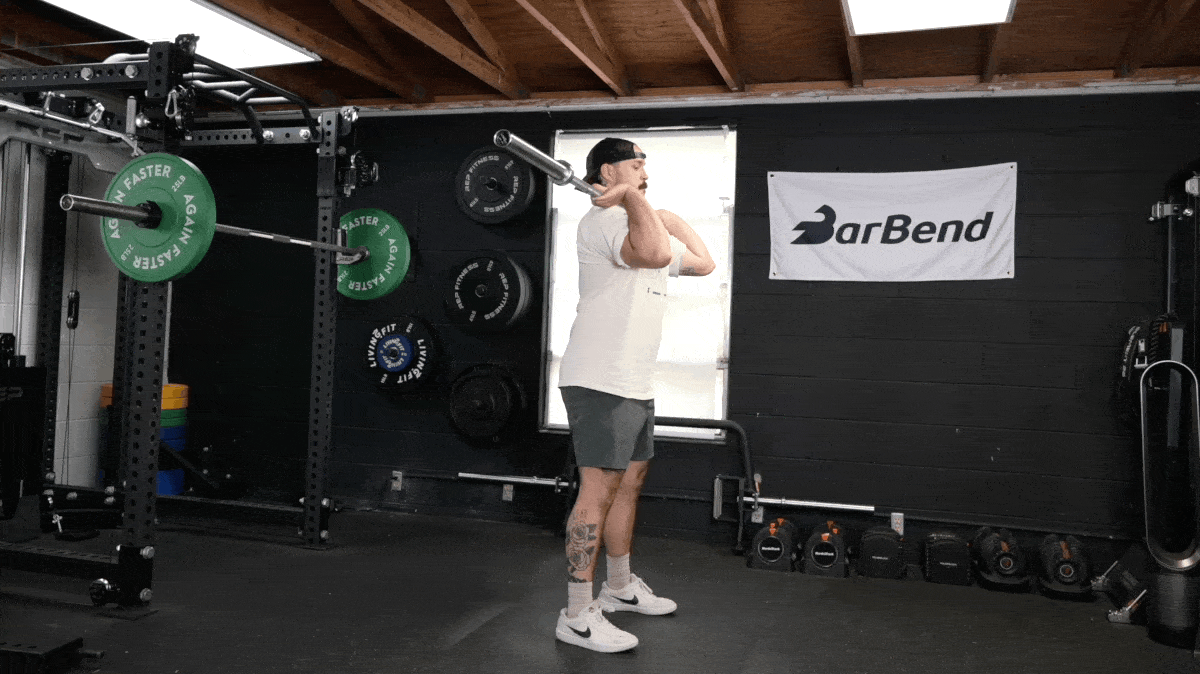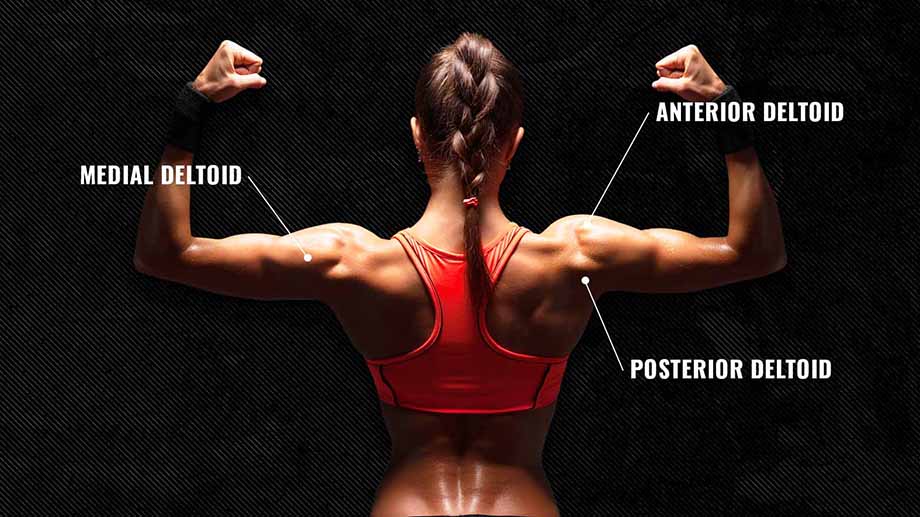Strong shoulders stand out. From the beach to the bodybuilding stage, we know how much of a difference it can make to train your shoulder muscles properly — and that’s without even mentioning the myriad of upper-body strength and stability benefits you can get from shoulder pressing with dumbbells. So, here’s how to perfect your dumbbell shoulder press form and carve your delts out of marble.
Recent Updates: This article was originally written by Daniel DuChateau, a lifelong lifting enthusiast and hobbyist powerlifter. On Mar. 12, 2024, it was revised and updated by BarBend‘s Senior Writer Jake Dickson. Dickson holds a B.S. degree in Exercise Science and is a NASM-certified personal trainer.
How To Do the Dumbbell Shoulder Press

| Equipment Needed | Weight bench, dumbbells, wrist wraps (optional) |
| Muscles Worked | Shoulders, triceps |
| Sets & Reps | 3 x 6-10 |
- Step 1 — Adjust the pad of an adjustable weight bench to a high angle.
- Step 2 — Grab two dumbbells and sit on the bench, pressing your back firmly against the pad and resting both dumbbells on your knees.
- Step 3 — Hoist one dumbbell to your shoulder at a time. You can kick your knee toward your head to help drive the dumbbell upward. Once both dumbbells are resting on your deltoids, adjust your elbows to be at about a 45-degree angle, pointing sideways.
- Step 4 — Press the dumbbells over your head, simultaneously driving your feet into the floor.
Modifications
- Make It Easier: Try holding the weights in a neutral palm position, with your elbows pointed forward instead of out to the sides.
- Make It Harder: Try doing the seated dumbbell shoulder press without the backrest. This will force your core to work much harder.
Dumbbell Shoulder Press Variations
Here are some popular variations of the dumbbell shoulder press to get you started if you want to experiment.
- Neutral-Grip Dumbbell Shoulder Press: If you’re experiencing shoulder pain, a neutral grip may decrease the strain on your shoulder compared to a more externally rotated position.
- Arnold Press: The concept of the Arnold press is that rotating your arm outwards as you press up engages all three deltoid heads to a greater degree. A 2017 study found that the Arnold press engaged the front and side delt more than the shoulder press. (1)
[Read More: Standing vs. Sitting Dumbbell Shoulder Press]
Dumbbell Shoulder Press Alternatives
If you’re interested in strength training, you should probably be familiar with the dumbbell shoulder press, but that doesn’t mean you need to do it. If you lack the equipment to perform the dumbbell shoulder press, or it’s just not your thing, you can try out some alternatives to hammer your shoulders.
Barbell Overhead Press

The main draw of the barbell overhead press, which is typically performed standing, is that you can drive more weight overhead for a greater amount of fatigue. If your primary goal is to get stronger, you want to focus on moving more weight over time. If you want to get bigger, your focus should be on stimulating your muscle tissue without creating too much full-body fatigue. Regardless of your goal, the barbell overhead press is a classic lift and a solid exercise.
Equipment Needed: Barbell, weight plates, squat or power rack, wrist wraps (optional), lifting belt (optional)
- Place a barbell in a power rack or squat stand with the j-hook set to roughly shoulder height. Load the barbell with an appropriate amount of weight plates.
- Get into the front rack position with your hands placed just outside your shoulders. (Play around with your hand positioning to find a grip that’s most comfortable for you.
- Drill your feet into the floor by rotating them into the ground (don’t actually turn your toward outward). Once you feel your glutes engage, drive the barbell overhead until your elbows are locked out.
- Slowly the bar back to the front rack position.
Push Press

The push press has one thing going for it that the barbell overhead press doesn’t — leg drive. By bringing your legs into the equation, you can push even more weight overhead. If you’re trying to push through a plateau on your overhead press, incorporating the push press can be helpful because it allows you to lift supramaximal loads. It’s also a common strength-based accessory movement for Olympic lifters, specializing entirely in getting big weights overhead.
Equipment Needed: Barbell, bumper plates, squat or power rack, wrist wraps (optional), lifting belt (optional)
- Set up exactly the same as you did for the barbell overhead press. Palace a loaded barbell in the J-hooks of a power rack set to about shoulder level. Unrack the barbell so it’s sitting in the front rack position.
- Steady the bar and then dip your knees to drop your hips a few inches.
- Drive back up and use that momentum to help drive the barbell over your head.
- Once you’ve locked the bar out, you can let the bar drop gently back to your chest.
Muscles Worked by the Dumbbell Shoulder Press
The seated (or standing) dumbbell shoulder press works your shoulders, but your shoulder isn’t just one muscle. Here’s a breakdown of the anatomy and how it works during this exercise:

- Anterior Deltoid: This muscle sits on the front of your shoulder and helps flex the joint, or lift your arm forward and up in space.
- Triceps Brachii: This three-headed arm muscle lies on the back of your upper arm and is responsible for locking your elbows out during the shoulder press.
- Posterior Deltoid: This tiny muscle lies on the back of your shoulder and performs a small, stability-focused role during the shoulder press.
- Abdominals: If you perform the dumbbell shoulder press standing up or without a backrest, your rectus abdominis and other core muscles will engage to stabilize your trunk.
Benefits of the Dumbbell Shoulder Press
If you’re unsure whether you should be doing the dumbbell shoulder press, consider some of the benefits listed below. There’s probably something here for you, no matter your fitness goals.
Bigger Shoulders
The barbell overhead press may give you the most bang for your buck in terms of pure overhead strength, but the dumbbell shoulder press can’t be beaten when it comes to muscle hypertrophy.
Subtle changes to your grip and elbow position help you stimulate your shoulders from all angles. Further, the grab-and-go convenience of dumbbells allows to quickly perform intensity techniques like drop sets and supersets.
There’s Lots of Versatility
You can tweak and tailor most dumbbell movements to fit your exact needs and bodily structure. Implements like machines or free weights can lock your body into a specific movement pattern. If you value versatility and comfort when you hit the weights, go for the dumbbell shoulder press.
May Help Address Imbalances
Working with two separate implements, like a pair of dumbbells, brings your stabilizers front and center. Small muscles in your upper back and shoulder girdle have to work overtime to ensure everything runs smoothly while you press.
[Read More: How To Do the Alternating Dumbbell Press (+ the Best Variations for Muscle and Strength)]
This also allows you to identify any side-to-side discrepancies that you might have. If your left shoulder is more flexible or powerful than your right, you’ll notice the difference very quickly when you perform the dumbbell shoulder press. This gives you a lane to address the issue and return to training.
Unparalleled Convenience
In a busy gym, you can swap out two pairs of dumbbells far more quickly than you can unload a barbell — never mind having access to press in in the first place. Dumbbells are also easy to store at home and are more practical to travel with.
Even if the dumbbell shoulder press isn’t a mainstay movement in your workout program, having a general familiarity with the exercise gives you the freedom to train your shoulders in nearly any circumstance as long as you have some dumbbells on hand.
Common Dumbbell Shoulder Press Mistakes
Given how much you can customize the dumbbell shoulder press, it’s crucial to identify and distinguish the mistakes that can occur while performing the lift.
[Read More: Try These Dumbbell Shoulder Workouts to Build Strength, Size, or Get Flexible]
Knowing the proper form can help you develop a more comprehensive understanding of the dumbbell shoulder press, so that if you choose to make changes to the lift, you’re doing so safely.
Leaning Back Excessively
By leaning too far back, you can inadvertently turn the dumbbell shoulder press into a quasi-incline bench press, recruiting your upper chest to help press the dumbbells. If this happens to you, the culprit may be insufficient flexibility at the shoulder.

[Read More: The 10 Best Shoulder Press Variations for Broader Delts]
If that’s not the issue, you could be too heavy to lift with good form. By keeping your back flush against the bench, or opting out of a backrest entirely, you can target your shoulders more directly.
Forcing Unnatural Movement Patterns
Your unique anatomical structure means someone else’s cues may not work well for you. Remember that the dumbbell shoulder press shouldn’t cause pain or discomfort at any point during the lift, and forcing unnatural movement patterns can reduce your stability and put you at an increased risk of injury.
[Read More: How to Do a Dumbbell Bench Press, With Expert Tips & Video Guide]
Before you write off the dumbbell press entirely, tinker with your elbow position (how wide you have your arms) and grip (how much you allow your wrists to bend) to see if that resolves any nagging discomfort. Don’t try to perfectly replicate the way someone else performs the press.
Not Locking Your Elbows Out
If you’re avoiding a full range of motion due to a potential injury or as a way to increase time under tension in a specific portion of the lift, feel free to disregard this one. Some gymgoers start their careers without ever learning to fully extend their arms over their heads.
[Read More: 5 Moves to Help Prevent Tennis Elbow in Strength Athletes]
Remember that at the top of the lift, your joints should be stacked on top of each other to ensure maximum stability. Working through a full range of motion from the get-go not only reinforces good habits, but makes lighter weights more effective for muscle growth.
Dropping the Dumbbells
It may seem silly when you’re first getting started, but once you’re working with heavy dumbbells, considering how you’ll get them down at the end of the set becomes an important part of the dumbbell shoulder press.
[Read More: The Best Dumbbell Sets for Your Home Gym]
Consider getting your spotter to take one of your dumbbells once you’re finished. Alternatively, you can bring your knees up one at a time to “catch” the dumbbells when lowering the weight back down. There’s no reason to chuck them from shoulder height onto the floor.
Frequently Asked Questions
What weight should a beginner shoulder press?
Your shoulders are strong muscles, but also need to be trained carefully, since the shoulder joint can move in so many different ways. If you’ve never trained your shoulders with weights before, start with light pressing exercises. Start with as light as 5 or 10 pounds and move up as long as you can maintain good form.
How do you increase how much you shoulder press?
The same way you increase your strength in any other movement; with patience and practice. Shoulder pressing involves working fairly small muscles, so you should exercise patience. Try doing 2 to 4 sets of shoulder presses twice per week with a moderately-challenging weight.
How many reps of the dumbbell shoulder press should you do?
You can’t use as much overall weight with dumbbells as you can with a barbell, most of the time. As such, you might want to up your rep count to compensate. Try doing anywhere between 6 and 12 reps of shoulder presses.
Who should do dumbbell shoulder presses?
Almost anyone can benefit from performing the dumbbell shoulder press! The exercise is particularly valuable for beginners who need to learn to control a weight overhead as well as bodybuilders wanting to grow and strengthen their front delts.
References
- Raizada, Shiny & Bagchi, Amritashish. (2017). Comparison among the EMG Activity of the Anterior Deltoid and Medial Deltoid During Two Variations of Dumbbell Shoulder Press Exercise. Indian Journal of Public Health Research & Development. 8. 653. 10.5958/0976-5506.2017.00411.9.
Featured Image: Slatan / Shutterstock